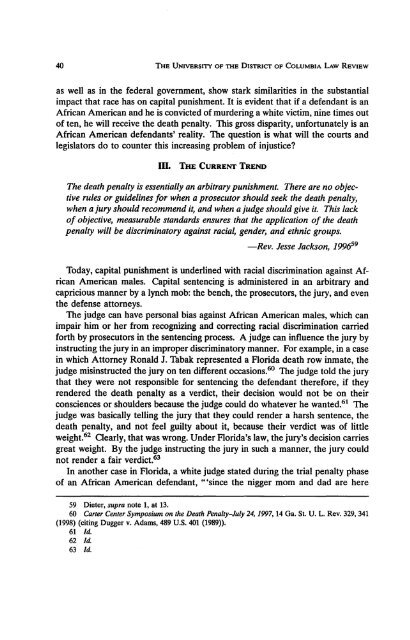The University of the District of Columbia Law ... - UDC Law Review
The University of the District of Columbia Law ... - UDC Law Review
The University of the District of Columbia Law ... - UDC Law Review
Create successful ePaper yourself
Turn your PDF publications into a flip-book with our unique Google optimized e-Paper software.
40 THE UNIVERSITY OF THE DISTRIcr OF COLUMBIA LAW REVIEWas well as in <strong>the</strong> federal government, show stark similarities in <strong>the</strong> substantialimpact that race has on capital punishment. It is evident that if a defendant is anAfrican American and he is convicted <strong>of</strong> murdering a white victim, nine times out<strong>of</strong> ten, he will receive <strong>the</strong> death penalty. This gross disparity, unfortunately is anAfrican American defendants' reality. <strong>The</strong> question is what will <strong>the</strong> courts andlegislators do to counter this increasing problem <strong>of</strong> injustice?IlL THE CURRENT TREND<strong>The</strong> death penalty is essentially an arbitrary punishment. <strong>The</strong>re are no objectiverules or guidelines for when a prosecutor should seek <strong>the</strong> death penalty,when a jury should recommend it, and when a judge should give it. This lack<strong>of</strong> objective, measurable standards ensures that <strong>the</strong> application <strong>of</strong> <strong>the</strong> deathpenalty will be discriminatory against racial, gender, and ethnic groups.-Rev. Jesse Jackson, 1996 59Today, capital punishment is underlined with racial discrimination against AfricanAmerican males. Capital sentencing is administered in an arbitrary andcapricious manner by a lynch mob: <strong>the</strong> bench, <strong>the</strong> prosecutors, <strong>the</strong> jury, and even<strong>the</strong> defense attorn~ys.<strong>The</strong> judge can have personal bias against African American males, which canimpair him or her from recognizing and correcting racial discrimination carriedforth by prosecutors in <strong>the</strong> sentencing process. A judge can influence <strong>the</strong> jury byinstructing <strong>the</strong> jury in an improper discriminatory manner. For example, in a casein which Attorney Ronald J. Tabak represented a Florida death row inmate, <strong>the</strong>judge misinstructed <strong>the</strong> jury on· ten different occasions. 60 <strong>The</strong> judge told <strong>the</strong> jurythat <strong>the</strong>y were not responsible for sentencing <strong>the</strong> defendant <strong>the</strong>refore, if <strong>the</strong>yrendered <strong>the</strong> death penalty as a verdict, <strong>the</strong>ir decision would not be on <strong>the</strong>irconsciences or shoulders because <strong>the</strong> judge could do whatever he wanted. 61 <strong>The</strong>judge was basically telling <strong>the</strong> jury that <strong>the</strong>y could render a harsh sentence, <strong>the</strong>death penalty, and not feel guilty about it, because <strong>the</strong>ir verdict was <strong>of</strong> littleweight. 62 Clearly, that was wrong. Under Florida's law, <strong>the</strong> jury's decision carriesgreat weight. By <strong>the</strong> judge instructing <strong>the</strong> jury in such a manner, <strong>the</strong> jury couldnot render a fair verdict. 63In ano<strong>the</strong>r case in Florida, a white judge stated during <strong>the</strong> trial penalty phase<strong>of</strong> an African American defendant, "'since <strong>the</strong> nigger mom and dad are here59 Dieter, supra note I, at 13.60 Carter Center Symposium on <strong>the</strong> Death Penalty-July 24, 1997,14 Ga. St. U. L. Rev. 329,341(1998) (citing Dugger v. Adams, 489 U.S. 401 (1989».61 [d.62 [d.63 [d.














